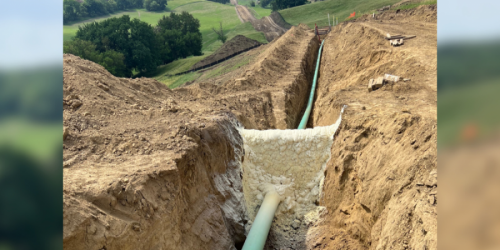Q&A Forums
slabjacking with GAP PRO Post New Topic | Post Reply
| Author | Comments |
|---|---|
|
paul rogers
Posted: Oct 25, 2013 06:54 PM
|
slabjacking with GAP PRO
I have 4 large sections of my own sidewalk that are tilted the wrong way. Towards the house instead of away from the house. Potential small ice rink in January that I do not want. I want to fix it before the wife MOANS about it!I have my old stand by: the Gap Pro gun. I have a plastic tapered cone fitting that can be used for slab jacking. Drill a 3/4" hole though the cement and put the cone end in the hole an spray some 110 degree foam into the void. (cooler than the normal 125-128 for Bayer CCXP) cone fitting attaches to the end of a threaded mixing chamber for flat tip spraying. So whoever has done this type of slab jacking please speak up. Cooler temps for delayed reaction is the correct method? I have 2 Fusion CS guns, but no attachments for slab jacking, thanks fellow foamers! |
|
SPRAYFOAM GODDESS
Posted: Oct 27, 2013 04:45 PM
|
You have a static mixer attachment? or the little tube thing? Either way, I would like to know how it goes, just because I am nosey. |
|
Patrick Burchett
Posted: Oct 31, 2013 10:22 AM
|
The issue you may have would be back pressure up through the 1/2" hole and back into your gun. Getting initial slab upward movement is typically when the most back pressure occurs. We have used the GX-7 for many years coupled with a special "packer" which is inserted into a 5/8" drilled hole. There are other guns being used such as the Fusion AP, but experience has shown that the GX-7 with the valving rod design greatly reduces or eliminates any back up into the gun. In your case of lifting a side walk section hole placement needs to be such that you don't have poly pushing out the side of the slab. Hole placement as far away from the edges and corners is ideal. If foam does start to come out from under the section, let off the trigger and allow the foam to set up creating a dam effect which should block any further foam for being wasted. Corner sections can be a times weak points in the slab. Especially since side walks are tied together with wire mesh rather than rebar. So try to stay back far enough with your injection holes. I can only recommend opertating temperatures and pressures for our TerraThane line of Geotech systems which this time of year adjustments need to be made on the ambient slab and soil temperatures. Similar to spraying walls with insulation foams, cooler or colder substrates tend to "suck" heat out of the foam. I typically recommend 120-130F on the pre-heater, 110F on the hose and 900 psi on the machine. Best practice is to shoot some poly into a box or bag to make note of its reaction time. Don't run your temperature to cold as you might get too slow a reaction and take a chance of "over lifting" the slab. Give me a call if you have any questions 817-915-9612 |
|
mason
Posted: Oct 31, 2013 11:04 AM
|
Discuss the project with your foam supplier. There are foams specifically designed for cavity fill that should be used for this type of application. Contact your supplier for their recommendations. A typical spray foam would not work well for this application due to the exothermic heat that builds up when it is sprayed in thicker lifts. Most foam suppliers have foams with a range of reaction times from 2-5 seconds to 2-6 minutes. You need a foam that has slow enough reaction times to fill the voids without creating too much exothermic heat but also exerts sufficient pressure during the fill to lift and support the slab. |
|
Patrick Burchett
Posted: Oct 31, 2013 11:16 AM
|
Mason,even the lifting/void fill foams create exothermic heats similar to spray foams. Knowing how much void area or having a good estimate on void area is an important pre-job inspection criteria. Unless a specially designed low exotherm system is used similar to those used for poly back fill or trench breaker applications excessive void area needs to be taken into consideration. In this case under a side walk the void area (cu/ft) is typically minimal. However in residential areas especially where there may be underground utilities, settlement in the utility trenches is come place. I agree 100%, insulation foams, roofing foams etc are not designed for this type work. For a light duty project such as this a 2.5 pcf system lifting/void fill poly would be recommend. |
|
paul rogers
Posted: Nov 17, 2013 07:21 PM
|
Did not move the slab. (maybe a little) drilled 1/2" hole to make the best seal with my cone attached to the gap pro mixing chamber. Screwed on the end of a flat tip mixing chamber. There was no void under the slab, but I tried anyway. I did not have the guts to keep the trigger pulled for 15-20 seconds! I am going to try again. Think 100 psi stuck on the hole could make a void? 3/8" tube on the end of the blow gun. spray some water in the hole 1st? got a 6' pry bar. Jack up the slab and cheat by filling the void that i just made? This may take a while but we will figure it out. |
|
Jerald Sargent
Posted: Nov 18, 2013 11:29 AM
|
Razorback, use whatever method works. I have a prybar, toe jacks and bottle jacks. Most of the time I just drill and pump but where the slab is narrow (less than five feet wide) you may need to alter the method. One thing to remember, you can't bend concrete, you raise one side or the other. On your walk settled toward the house you will need at least two holes per slab along the wall about a foot or two out from the wall, less if the slab is narrow. This may cause blowout but you cannot have foam moving the other direction or you will create lift on the side you don't want it. unlike mudjacking, using poli does not lift from the point of injection, it lifts from where the foam is pushed as it blows back through the already injected foam. On an AP gun this is where the air pushes through and is often not in the ideal place you may want it. Go slow, cut joints and use what ever tools (pry bar, jacks) you need to make it work. |





























